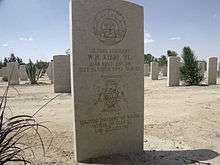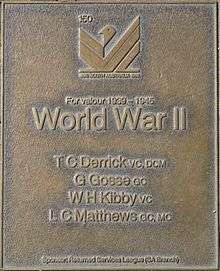Bill Kibby
| William Henry Kibby | |
|---|---|
|
William Kibby | |
| Born |
15 April 1903 Winlaton, County Durham, England |
| Died |
31 October 1942 (aged 39) El Alamein, Egypt |
| Buried at | El Alamein War Cemetery |
| Allegiance | Australia |
| Service/branch | Australian Army |
| Years of service | 1936–42 |
| Rank | Sergeant |
| Battles/wars |
Second World War |
| Awards | Victoria Cross |
William Henry "Bill" Kibby, VC (15 April 1903 – 31 October 1942) was a British-born Australian recipient of the Victoria Cross, the highest award for gallantry in the face of the enemy that can be awarded to British and Commonwealth forces.
Early life
Kibby was born at Winlaton, County Durham, England on 15 April 1903. In early 1914, the family emigrated to Adelaide, South Australia, where Bill attended Mitcham Public School. After leaving school he was employed at a plasterworks in Edwardstown, where he designed and fixed plaster decorations. In 1926, he married Mabel Sarah Bidmead Morgan; they lived at Helmsdale and had two daughters.
Although he was diminutive (168 cm (5 ft 6 in)), Kibby was a strong man and loved outdoor activities. In 1936, he joined the Militia, and was assigned to the 48 Field Battery, Royal Australian Artillery.
Second World War
Kibby joined the Second Australian Imperial Force during the Second World War. In 1942, he was a sergeant in the 2/48th Infantry Battalion, during the North African campaign.
At the Second Battle of El Alamein, during the period of 23–31 October 1942, Kibby distinguished himself through his skill in leading a platoon, after his commander had been killed, during the initial attack at Miteiriya Ridge. On 23 October, he charged a machine gun position, firing at it with his Thompson submachinegun; Kibby killed three enemy soldiers, captured 12 others and took the position. His company commander intended to recommend him for the Distinguished Conduct Medal after this action, but was killed. During the following days, Kibby moved among his men directing fire and cheering them on. He mended his platoon's telephone line several times under intense fire. On 30–31 October, the platoon came under intense machine gun and mortar fire. Most of them were killed or wounded. In order to achieve his company's objective, Kibby moved forward alone, to within a few metres of the enemy, throwing grenades to destroy them. Just as his success in this endeavour appeared certain, he was killed.[1]
His Victoria Cross was awarded posthumously and is displayed at the Australian War Memorial. He is buried at the Commonwealth War Grave at El Alamein.

References
- ↑ The London Gazette: (Supplement) no. 35879. p. 523. 26 January 1943. Retrieved 17 June 2015.
External links
- Bill Gammage, 'Kibby, William Henry (Bill) (1903–1942)', Australian Dictionary of Biography, Volume 15, Melbourne University Press, 2000, pp 15–16.
- Sergeant W.H. Kibby in The Art of War exhibition at the UK National Archives
